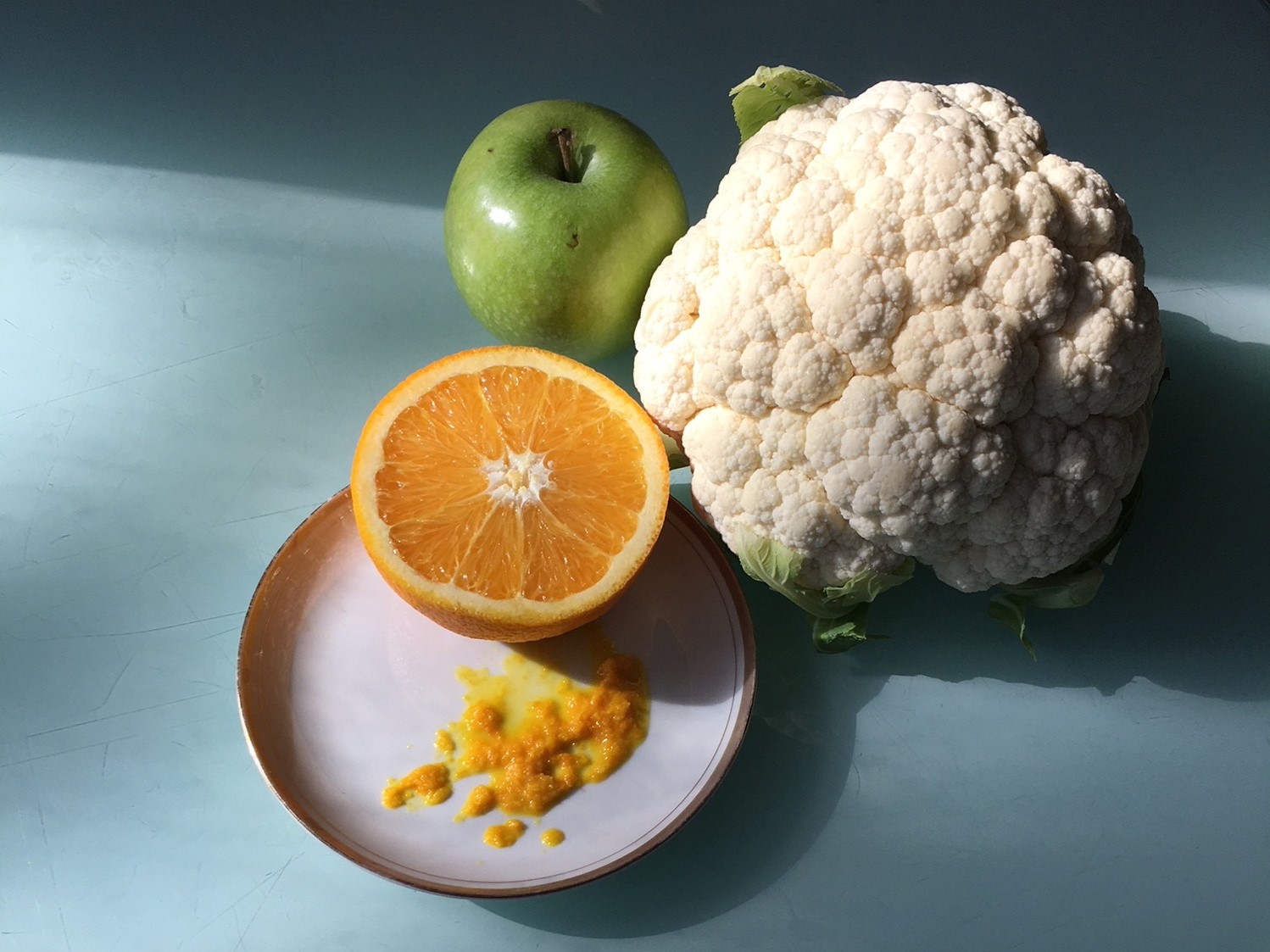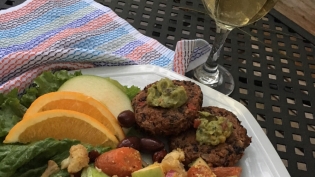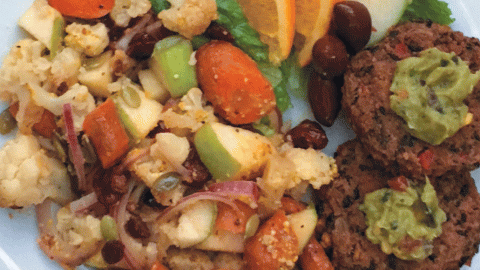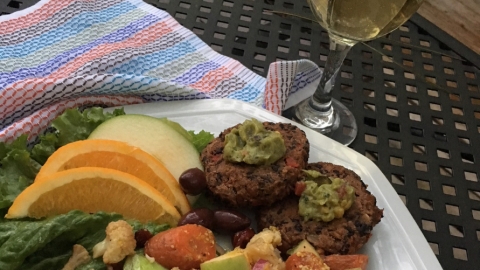A Personal Journey to Health: Eat to Live, Live to Eat
A few years ago, I was diagnosed with cancer. As I neared the end of my treatment, some of my friends and family asked me what I would do differently to maintain my health. I didn't know. My genes said I was predisposed to become sick. My doctors said I needed lots of regular testing. Lots. Suddenly I had become a person with a chronic condition, knee-deep in a medical system of drugs, tests and vigilance. I felt like I had been booted out of the driver seat of my life.
Prescription for What's Next
Dr. Kerry Graff of Canandaigua, New York, tells her patients with chronic diseases that they have a lot more control than they think. In fact, she was dealing with the symptoms of several chronic conditions herself, including pre-diabetes, acid reflux, chronic constipation, hypothyroidism and depression, before she made some telling lifestyle changes.
After practicing medicine for more than 16 years, Graff saw the documentary Forks Over Knives, which advocates a whole food plant-based diet (WFPB). She decided to try it out for herself. As her symptoms subsided and she lost excess weight, patients, friends and family asked her what was going on. She had found a prescription for good health on her dinner plate, and it made her reconsider the way she ran her practice. Once she began, as she puts it, pushing broccoli and beans instead of pills and procedures, her patients saw remarkable results. For her, there was no turning back. She not only embraced the WFPB diet, she is now an ambassador for it as an educator and chief medical officer for 4Leaf Global, a program advocating healthy eating and plant-based nutrition.
It's not really a secret. There is overwhelming evidence that lifestyle choices impact your health. The Centers for Disease Control and Prevention (CDC) and World Health Organization (WHO) advise that 80 percent of chronic diseases can be prevented or managed by making good lifestyle decisions. That said, the health stats for our country are alarming.
Over Half of Our Nation's Adults are Sick
According to the CDC, 60 percent of adults in the U.S. have a chronic disease such as heart disease, cancer, diabetes, Alzheimer’s or arthritis. Forty percent have two or more.
Why are people so willing to accept living with a chronic condition? Many physicians are not trained to look at food and lifestyle choices as medicine. Instead, they turn first to pharmaceutical solutions and medical procedures. And patients trust this approach.
So, How are You?
There is little doubt that if you are reading this magazine you appreciate luscious food served on a beautiful plate in a lovely scenic setting, probably sitting with good friends and maybe having a glass of wine. Perhaps you walked to the restaurant or spent the afternoon hiking, pulling weeds or shoveling snow. Congratulations! You may have much in common with people in the world who live the longest.
I am intrigued that people who live in what researchers dubbed Blue Zones enjoy a lifestyle that promotes good health and longevity—living far longer than the average global life expectancy of 72 years. Although these zones are scattered around the world, scientists found that they shared some common lifestyle habits: a healthy diet (mostly based on local plants), daily exercise, and a low-stress life supported by purpose and faith. Often these people end their day in a lovely scenic setting sharing a glass of wine with friends or family.
Checking In
No one promises you tomorrow, but the thought that I do have a lot of control—let's call it responsibility—for my health is empowering. Post-surgery and treatment I had some work to do. When you are in pain, building an exercise plan and social support plus finding motivation to reduce stress are challenging. All these take time to shape as you add and remove pieces of your life to make things work better. But a healthy diet? You can change how you eat with your next bite. Besides, I thought I had that part nailed. I'm a vegetable farmer, after all.
Easy or Confusing?
Many existing strategies for maintaining health share common factors, but also differ in significant ways. So, I asked Allyson Odachowski RDN, CDN, a registered dietitian with a practice in Western New York, what a healthy diet looks like. She shared some tips from the Dietary Guideline for Americans from the Office of Disease Prevention and Promotion of Health and advice from the American Institute for Cancer Research. They recommend dishing up plenty of vegetables, fruits and whole grains. Odachowski says to cover 2/3 to 3/4 of your plate with plants. The guidelines also say to limit your sugar and fat intake to less than 10 percent each of your daily calories. By cooking with whole foods at home you can avoid hidden and excess fats, salts and sugars that get added in processing.
No big surprises there. Branded diets like Forks Over Knives, 4Leaf Global or Dr. Ornish's Lifestyle Medicine and plans like the Mediterranean diet all offer similar advice: Fill your plate with veggies. Incidentally, Dr. Ornish's plan was one of the first lifestyle plans to be paid for by Medicare—an encouraging trend by insurance companies that started about a decade ago and continues today with Medicare recently agreeing to pay for a Type 2 Diabetes Prevention lifestyle plan.
Food for Thought
Inflammation is commonly considered a cause of many chronic conditions such as heart disease and arthritis, and it is associated with several others such as cancer. Thus, various diet plans claim to strategically address inflammation. An anti-inflammatory diet's goal is to provide balanced nutrition through a combination of vegetables, fruits, protein, fiber, healthy fats and antioxidants.
Most experts agree that a diet that leans heavily on vegetables is great. Green and colorful vegetables are especially nutrient dense and filled with antioxidants, minerals and phytonutrients that discourage inflammation. Where anti-inflammatory diet plans differ is, in part, due to how factors that influence inflammation are calculated. If you read a nutrition label it seems like food and its impact can be charted very simply. In reality, food and our interaction with it are very complex, and naturally, interpretations will differ.
Monica Reinagel, MS, LD/N, CNS and host of the Nutrition Over Easy blog (born in Buffalo, by the way) is attempting to quantify and calculate the anti- and pro-inflammatory characteristics of over 2,500 foods with an algorithmic formula. Her product gives a score to each food item. An orange, for example, has both a glycemic load (pro-inflammatory) and a host of antioxidants (anti-inflammatory) as well as at least 24 other measured factors. The final score puts an orange on the positive side of being an anti-inflammatory food. Some other anti-inflammatory diets actually don't favor citrus as much. She cautions that the score is just a tool to help people understand the nature of the food on their plate.
Eat Meat or Not?
One basic difference between many of the branded diets comes down to the role of meats, dairy and fat in meal plans. I would put Forks Over Knives, 4Leaf Global and Dr. Greger, author of How Not to Die at one end of the spectrum. These diets advise eating no animal products at all and suggest limited use of oils in cooking and dressings (including what some consider good oils, like olive oil). It is advised that the limited amount of good fat needed should come from whole foods like nuts or avocados. The Ornish plan is considered lacto-ovo vegetarian, which means it includes dairy and eggs so it lands further along the spectrum.
The Dietary Guidelines for Americans include options to eat fat-free or low-fat dairy or if needed/desired a dairy alternative and a variety of protein foods including seafood, lean meats and poultry, eggs, legumes, nuts, seeds and soy as part of a healthy eating strategy. The Mediterranean diet, Perricone diet and Zone diets are plans that also advocate eating high-quality proteins and particular fats as part of your meal plan … again, each a little different. As an example, the Mediterranean diet suggests eating fatty fish like mackerel or salmon on a regular basis because they are good sources of omega-3 fatty acids. These fatty acids play a role in lowering the risk for the development of heart disease by combating inflammation and also help to maintain cognitive function. The Mediterranean diet advocates eating wild foods like purslane, a vegetable that is high in omega-3 fatty acids as well as some valued minerals, so folks who prefer to omit animal products cite this plant as an example of how to achieve comprehensive nutrition within a plant-based diet.
Elizabeth Miller, MS, RDC, CDN, clinical coordinator of Dietetics Center, SUNY, Buffalo, says that the Mediterranean and the MIND diets are good to follow because they offer a well-balanced approach. She says your body needs a balance of nutrients, minerals and fiber, and recommends using the Yum.ly app to fine-tune your recipe searches. You can set filters to match a number of requirements including diet type. You just need to figure out what your diet type is!
How Do You Fold Your Napkin?
When I was little, one of my favorite jobs was to set the dining table with decoratively folded napkins. I could choose the design as long as I followed the rules for proper placement. For me, that set the stage for a wonderful meal.
Figuring out the proper rules for what to put on your plate might prove more challenging. But prioritizing colorful plants is a good place to start, and as you fine-tune your diet to meet your personal needs you will be making choices that are influenced by your lifestyle, family history and goals. Listening to how your body responds is key. If the choices seem overwhelming, seek help from a dietitian, healthcare provider or counselor. You can simply aim for a plate that is filled three quarters with veggies or you can be more exacting. Either way, deciding what food you should eat should not be a source of stress. Remember, we are trying to eliminate stress in our lives and have some fun while we dine as part of a healthy living strategy.
Meanwhile …
Five years after my diagnosis, I've come a long way in checking off items on my healthy lifestyle list. I'm cancer-free but remain vigilant and still get lots of tests. From having little energy, I've evolved to keeping a robust exercise schedule. In addition to farming (bending, squatting, weeding) I can dance or run every day. My social support has gone up and stress has gone down. There's time in my week for contemplation and meditation, checking off the box for faith. The tweaks I made to my eating habits— reducing sugar intake and eliminating almost all dairy, while piling even more vegetables on my plate—helped to enable the rest of the changes. And, I like to end my days in a lovely scenic setting with friends around the dinner table sharing a glass of wine.














